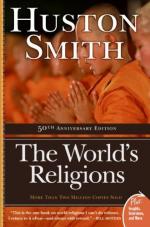
|
| Name: _________________________ | Period: ___________________ |
This test consists of 15 multiple choice questions and 5 short answer questions.
Multiple Choice Questions
1. What practice does the Eastern church encourage more so than the Roman church?
(a) Establishing religious orders
(b) Venerating the Virgin
(c) Mysticism
(d) Marriage as a sacrement
2. What comprised the majority of the major prophets' work in Jewish history?
(a) Judging civil cases
(b) Denouncing the misuse of ruling authority
(c) Annointing of new kings
(d) Giving the Jewish Law to the people
3. What was the scratched drawing that came to identify Christians with the Good News?
(a) The star of David
(b) The sign of the fish
(c) The ankh
(d) The eye of God
4. How do Jewish people view their traditions?
(a) As handles on the real world around them
(b) As unimportant except for the fun they bring
(c) As the memories of the past which are treasured possessions
(d) As meaningless ritual
5. What are the basic concepts of Islam?
(a) God, Creation, humanity, and the Day of Judgment
(b) Converting, practice, judgment, and reward
(c) Birth, life, death, and judgment
(d) Prophecy, subjugation, and war on infidels
6. What is the function exclusive to the shaman in primal religion?
(a) To deal only with evil spirits
(b) To make symbols for the tribe to see but not understand
(c) To teach the youth about tribal traditions
(d) To bypass symbolism and go directly to the spiritual source
7. What major change did Islam cause?
(a) Tollerance for different religions
(b) Exemplifying the different classes of people
(c) Putting women on an equal status as men
(d) Great social and moral change among the Arabic people
8. How have Taoism and Confucianism affected the Chinese culture?
(a) The combination has enriched the culture.
(b) The combination has diffused the culture.
(c) Their similarities have complicated the culture.
(d) Their competition has confused the culture.
9. How is it said that Jews are more united?
(a) In who they know rather than what they know
(b) In where they live rather than how they live
(c) In how they do business than where they do business
(d) In what they do rather than what they think
10. What does Huston Smith suggest as a better way to assess religions?
(a) By selecting only the ones that appeal to you
(b) By asking what wisdom do they offer the world
(c) By looking for absurdities
(d) By studying each one for years
11. What is the Jewish attitude toward history?
(a) It only makes interesting stories and bedtime reading.
(b) It is over and should be forgotten while working toward perfection.
(c) It highly significant revealing the contest of life that delineates methods of handling problems and taking advantage of opportunities.
(d) It has nothing to do with how life is lived in the present.
12. How can the gods of cultures other than the Jewish people be described?
(a) Immoral, indifferent and capricious
(b) Personal, effective, and powerful
(c) Loving, gracious, and kind
(d) Idealstic, ethereal, and silent
13. Where did the Jews find a greater meaning in life?
(a) Through mysticism
(b) Through troubles
(c) Through philosophy
(d) Through revelation
14. What is wrong with science questioning religion's ability to answer questions of ultimate reality?
(a) Science cannot find a cure for the common cold.
(b) Science is not concerned with it.
(c) Science has also been unable to answer those questions.
(d) Science has facts to work with.
15. How do Muslims view the Koran?
(a) As a book without specific rules
(b) Simply as the words of Allah
(c) As a history of the relationship between God and man
(d) As a history of the Prophet
Short Answer Questions
1. What saves the Christian in spite of his imperfect nature?
2. What is the main thing gleaned from reading the Tao Te Ching?
3. What are the three areas of mysticism in Sufism?
4. What two things became most important after Rome destroyed the temple in Jerusalem?
5. How is the length of Jesus' ministry best described?
|
This section contains 704 words (approx. 3 pages at 300 words per page) |

|




